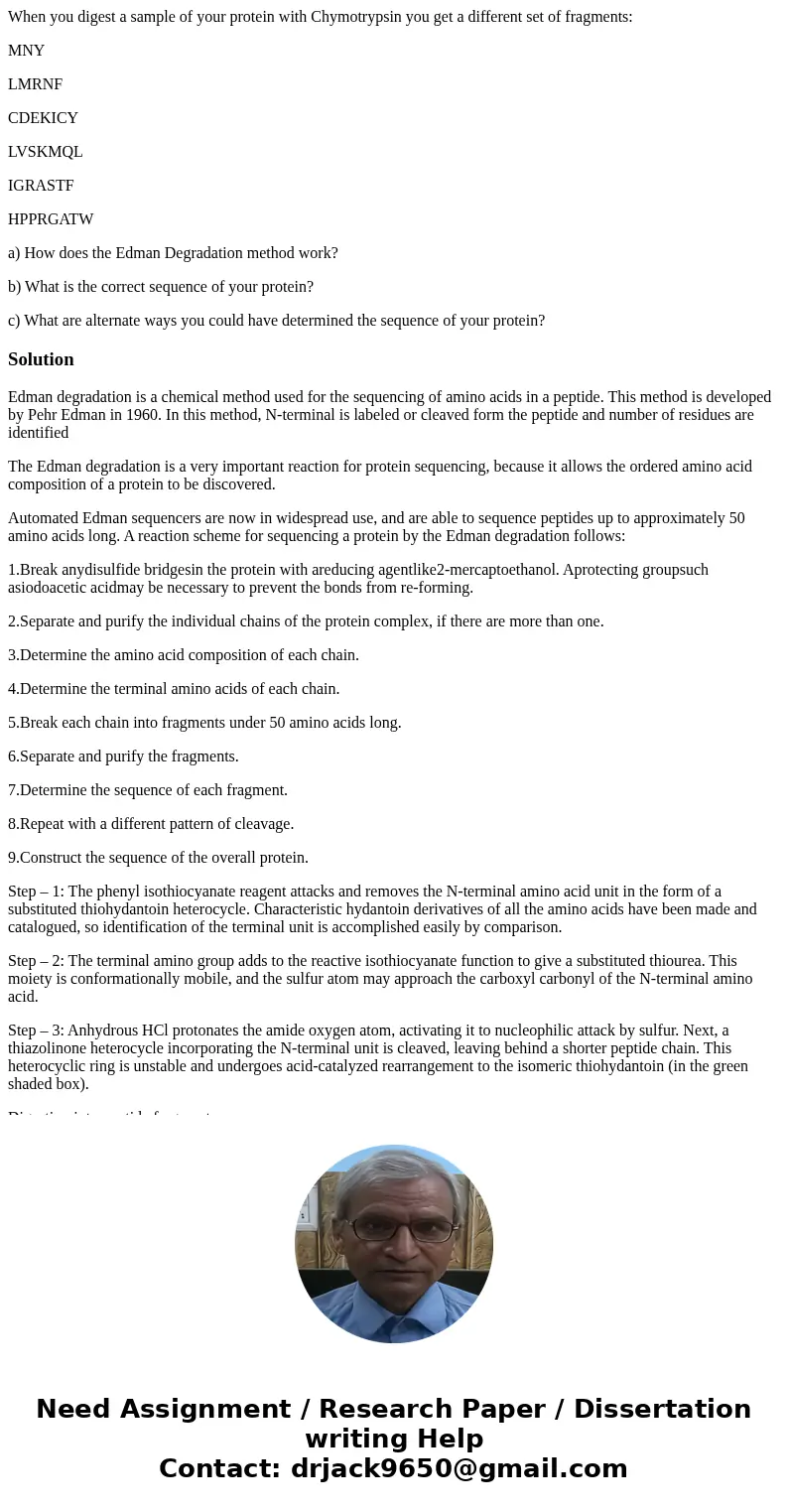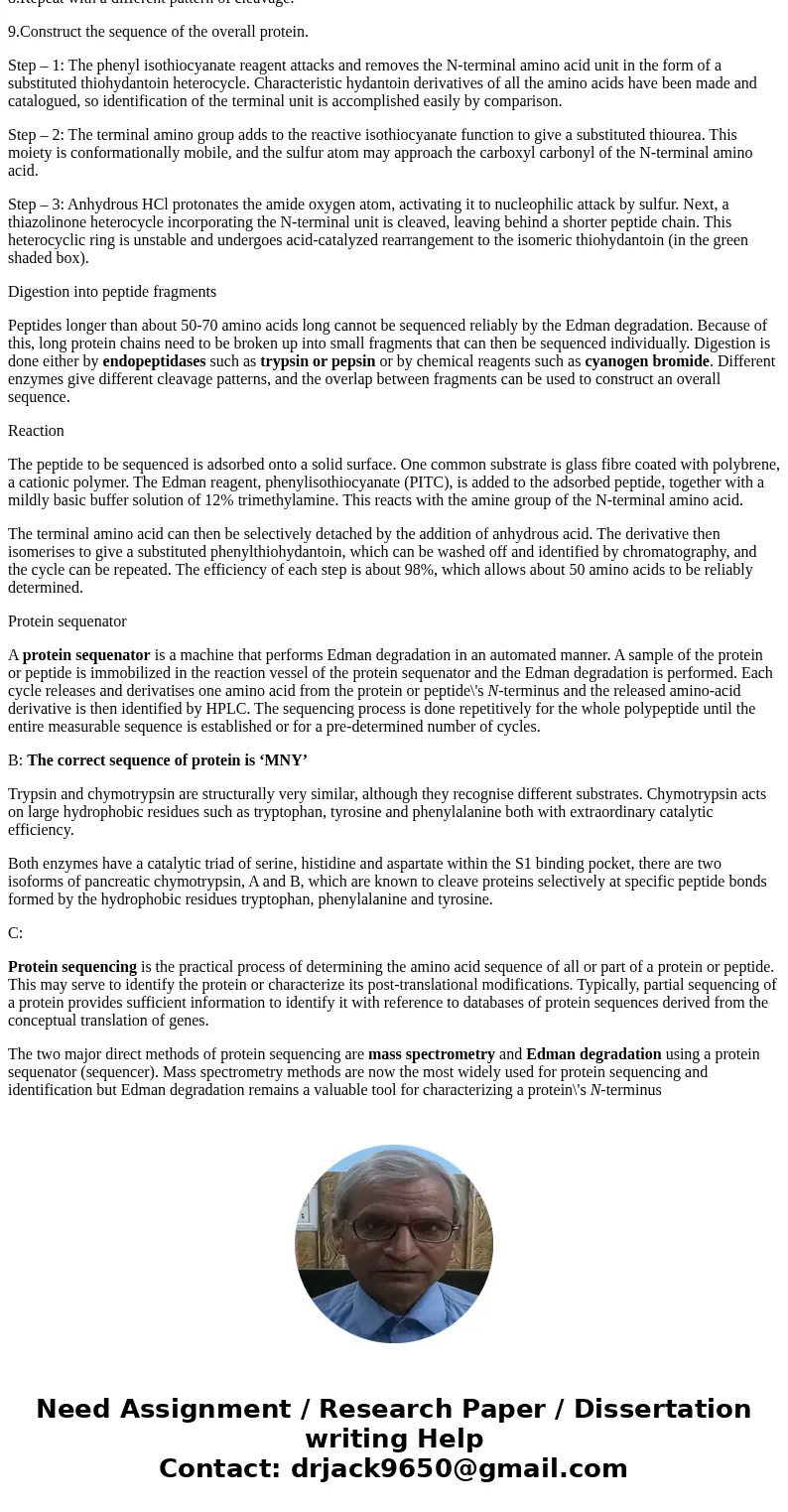When you digest a sample of your protein with Chymotrypsin y
When you digest a sample of your protein with Chymotrypsin you get a different set of fragments:
MNY
LMRNF
CDEKICY
LVSKMQL
IGRASTF
HPPRGATW
a) How does the Edman Degradation method work?
b) What is the correct sequence of your protein?
c) What are alternate ways you could have determined the sequence of your protein?
Solution
Edman degradation is a chemical method used for the sequencing of amino acids in a peptide. This method is developed by Pehr Edman in 1960. In this method, N-terminal is labeled or cleaved form the peptide and number of residues are identified
The Edman degradation is a very important reaction for protein sequencing, because it allows the ordered amino acid composition of a protein to be discovered.
Automated Edman sequencers are now in widespread use, and are able to sequence peptides up to approximately 50 amino acids long. A reaction scheme for sequencing a protein by the Edman degradation follows:
1.Break anydisulfide bridgesin the protein with areducing agentlike2-mercaptoethanol. Aprotecting groupsuch asiodoacetic acidmay be necessary to prevent the bonds from re-forming.
2.Separate and purify the individual chains of the protein complex, if there are more than one.
3.Determine the amino acid composition of each chain.
4.Determine the terminal amino acids of each chain.
5.Break each chain into fragments under 50 amino acids long.
6.Separate and purify the fragments.
7.Determine the sequence of each fragment.
8.Repeat with a different pattern of cleavage.
9.Construct the sequence of the overall protein.
Step – 1: The phenyl isothiocyanate reagent attacks and removes the N-terminal amino acid unit in the form of a substituted thiohydantoin heterocycle. Characteristic hydantoin derivatives of all the amino acids have been made and catalogued, so identification of the terminal unit is accomplished easily by comparison.
Step – 2: The terminal amino group adds to the reactive isothiocyanate function to give a substituted thiourea. This moiety is conformationally mobile, and the sulfur atom may approach the carboxyl carbonyl of the N-terminal amino acid.
Step – 3: Anhydrous HCl protonates the amide oxygen atom, activating it to nucleophilic attack by sulfur. Next, a thiazolinone heterocycle incorporating the N-terminal unit is cleaved, leaving behind a shorter peptide chain. This heterocyclic ring is unstable and undergoes acid-catalyzed rearrangement to the isomeric thiohydantoin (in the green shaded box).
Digestion into peptide fragments
Peptides longer than about 50-70 amino acids long cannot be sequenced reliably by the Edman degradation. Because of this, long protein chains need to be broken up into small fragments that can then be sequenced individually. Digestion is done either by endopeptidases such as trypsin or pepsin or by chemical reagents such as cyanogen bromide. Different enzymes give different cleavage patterns, and the overlap between fragments can be used to construct an overall sequence.
Reaction
The peptide to be sequenced is adsorbed onto a solid surface. One common substrate is glass fibre coated with polybrene, a cationic polymer. The Edman reagent, phenylisothiocyanate (PITC), is added to the adsorbed peptide, together with a mildly basic buffer solution of 12% trimethylamine. This reacts with the amine group of the N-terminal amino acid.
The terminal amino acid can then be selectively detached by the addition of anhydrous acid. The derivative then isomerises to give a substituted phenylthiohydantoin, which can be washed off and identified by chromatography, and the cycle can be repeated. The efficiency of each step is about 98%, which allows about 50 amino acids to be reliably determined.
Protein sequenator
A protein sequenator is a machine that performs Edman degradation in an automated manner. A sample of the protein or peptide is immobilized in the reaction vessel of the protein sequenator and the Edman degradation is performed. Each cycle releases and derivatises one amino acid from the protein or peptide\'s N-terminus and the released amino-acid derivative is then identified by HPLC. The sequencing process is done repetitively for the whole polypeptide until the entire measurable sequence is established or for a pre-determined number of cycles.
B: The correct sequence of protein is ‘MNY’
Trypsin and chymotrypsin are structurally very similar, although they recognise different substrates. Chymotrypsin acts on large hydrophobic residues such as tryptophan, tyrosine and phenylalanine both with extraordinary catalytic efficiency.
Both enzymes have a catalytic triad of serine, histidine and aspartate within the S1 binding pocket, there are two isoforms of pancreatic chymotrypsin, A and B, which are known to cleave proteins selectively at specific peptide bonds formed by the hydrophobic residues tryptophan, phenylalanine and tyrosine.
C:
Protein sequencing is the practical process of determining the amino acid sequence of all or part of a protein or peptide. This may serve to identify the protein or characterize its post-translational modifications. Typically, partial sequencing of a protein provides sufficient information to identify it with reference to databases of protein sequences derived from the conceptual translation of genes.
The two major direct methods of protein sequencing are mass spectrometry and Edman degradation using a protein sequenator (sequencer). Mass spectrometry methods are now the most widely used for protein sequencing and identification but Edman degradation remains a valuable tool for characterizing a protein\'s N-terminus


 Homework Sourse
Homework Sourse